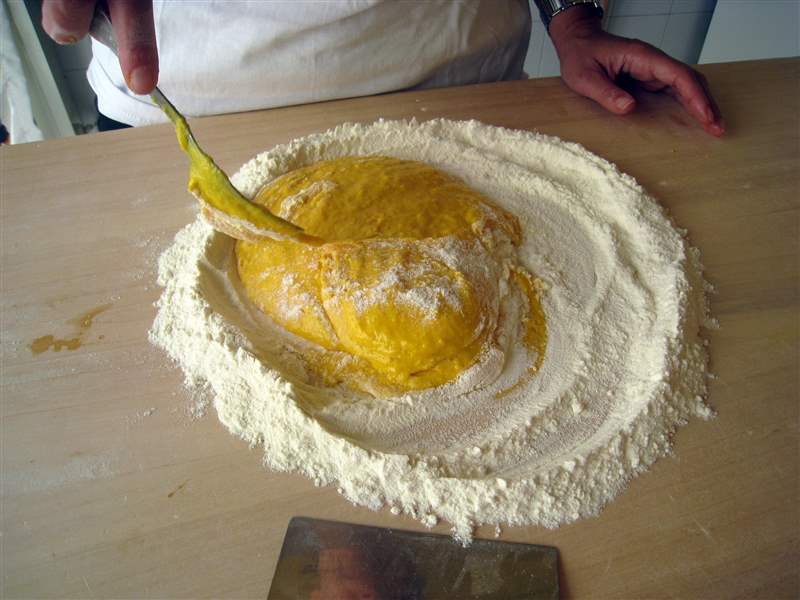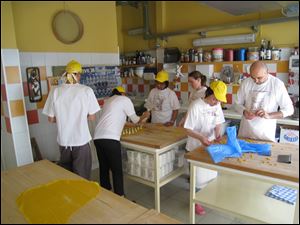
In Italy, learning to make pasta the hands-on way
8/23/2011
Students learn to make Bolognese pasta.
WASHINGTON POST/BRENT CUNNINGHAM

Students prepare tortellini and tortelloni at La Vecchia Scuola pasta school in Bologna, Italy.
In his memoir Heat, author Bill Buford fulfills every food lover's dream and heads to Italy to learn to make pasta. There, in the town of Porretta, he is told to sit and watch. "Watching is good," his instructor, Betta, tells him every day for 10 days before she lets him pick up a piece of dough. "That was how I learned as a child: hours and hours, watching my aunts."
This is not the philosophy at La Vecchia Scuola Bolognese, a kind of boot camp for aspiring pastamakers, or sfoglini. Tucked away in a residential section of Bologna, a city with no equal when it comes to pasta technique, the school has even amateur students mixing dough, kneading, rolling, and shaping garganelli, farfalle, tortellini, and pappardelle for more than three hours before they sit down, exhausted, to eat it. All of it.
I considered my pastamaking skills pretty good, for an American anyway. Using the roller attachment on my mixer, I'd made linguine and tagliatelle and received rave reviews from my (also American) guests. But our teacher, Simone Tufano, disagreed. "You do not make pasta with a machine," he said. "Here, we don't even talk about machines." Real pasta, Tufano explained, is rolled by hand, because that method leaves tiny imprints in the dough to which the sauces will cling. Machine-rolled pasta is perfectly flat and therefore utterly imperfect.
La Vecchia Scuola, opened in 1993 by Bolognese pasta queen Alessandra Spisni, is housed in what seems to have once been an apartment. The kitchen has cheery yellow and orange tiles. Three long, rectangular wooden tables stand beside a plate-glass window overlooking the street. Our class of four students began by making the dough, one egg for every 100 grams of pasta flour. Bolognese pasta is famous for its golden hue, and it was obvious where that color came from when I cracked open the first egg. The yolk was a brilliant orange, almost crimson, which is why the yolk is called "il rosso" in Italian. The chickens, Tufano informed us, are specially raised to produce eggs for pasta and receive plenty of tomato and carrot scraps in their feed.
Next, we kneaded: We crushed the dough under our palms, then folded it in half. Then we stretched it and folded it again until it became shiny and pliable. It took longer than I expected. But it wasn't a challenge to get the consistency right. Rolling it out, on the other hand, requires serious skill.
We were each given a tapered rolling pin about three feet wide. Tufano showed us how to use it, starting with our hands at the edge of the pin and moving them inward as we pushed the dough away from us. To turn it, we tipped the far edge of the dough over the pin and rolled it up like a scroll before setting it back down on the table. The goal was to make a perfectly round, perfectly thin circle. My first attempt was judged "not bad" by Tufano, though he pointed out that it looked a lot like Australia.
If I thought I was "not bad," that impression was corrected by what was happening at the third table in the kitchen. There, veteran employees were rolling and shaping dough at warp speed. Roll, roll, roll. Turn. Roll, roll, roll. Turn. Cut. Fill. Shape. Next! Clearly, there is something to watching an expert at work.
When it comes to shaping pasta, though, there's no substitute for hands-on practice. I was amazed at how easy it was to make garganelli, a ridged, tube-shaped pasta. You simply take a small rectangle of dough and fold the two far corners together over a little wooden wand. Then you roll each one on a "comb," which forms the ridges.

Students learn to make Bolognese pasta.
Tortellini, in contrast, were a challenge. The pasta is filled with big flavors -- mortadella, prosciutto, and parmesan -- and served in a rich broth, so you don't want them to be very big. This means that small fingers are useful in shaping the tiny circles. My husband, Brent, struggled to bring the corners together without tearing the dough. All of us labored to make sure the dough would be lump-free to allow for even cooking.
By Bolognese standards, our pasta, with its lumps and inconsistent filling, was not fit to serve to guests. But by mine, it was pretty spectacular. After more than three hours of pastamaking, we sat down to a feast: a plate of mortadella, a must at any meal in Bologna, then a tureen of tortellini in brodo, of which I had two helpings before realizing that we would also be served the tender tortelloni we'd made, stuffed with spinach and ricotta, in a butter sauce and pappardelle in a meat ragu.
If we hadn't made it, we couldn't have eaten it. And that would have been a shame.